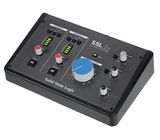I bought this interface, after a recommendation from my friend and testing his unit in action. After two weeks I decided to give it a shot.
I've been using it for 6 months since and it is a very solid product, but it has some flaws, which may or may not affects the overall experience - depending on the user.
1. Sound quality - preamps have very clean, pristine sound, and enough gain to drive an SM7B. They work well on line, instrumental, and mic input - DI guitar and bass sound really good.
Headphone outputs have enough power to feed both AKG K271 and Audio-Technica MX40, and they can be really loud - halfway through is more than enough for me but I have not checked them on any high-impedance headphones (AKG have 55 Ohms, AT - 35 Ohms).
The 4K buttons boost signal a few dB and add some noise - sometimes it can be used creatively (e.g. on DI bass or even microphone ) but if you want a really clean sound, they will indeed distort the signal.
Monitor outputs are loud - I have never reached past 12 o'clock during usual work and my room is about 20 square meters big.
I use Yamaha HS5 with SSL2.
2. Build quality - the knobs are really good. Especially the main monitor knob is very pleasant to touch and turn - just like in the real SSL console.
The buttons for phantom power, line, and HI-Z feel like they are of worse quality than the rest of the interface. Up until this point I have not had any problems with them but my friend told me that some of them fell off. There is space for improvement.
Overall the interface's chassis feel sturdy and solid, as well as the in/out sockets on the rear.
One last thing: it is made in China and for some of you it can be a deal-breaker, so bear that in mind. But on the other hand, what isn't built in China these days?
3. Usage experience - it is a very nice, little interface with good preamps quality and good drivers.
I work on PC, in 48KHz and 128spls and the latency in both Reaper and Ableton are around 5,1/4,5 which is very usable, at least for me.
But it would probably be nice to have a TB3 version of SSL2 because I can see no real difference between USB A and C connectors in this case.
The monitor mix knob, which is more and more common on modern interfaces is a nice feature to have while recording. MIDI I/O is also very nice to have.
The fact that all of the I/O are on the back could be problematic for some of the users. I think that having the DI-ins and headphone outs on the front panel would be useful. But it would definitely affect the neat look of the interface ;)
To sum up - I truly recommend SSL2+ for mixing in-home studio and some small recording sessions it can be an ideal piece of gear .
What I would really like to see in the future is a version with 4 preamps and an ADAT I/O as well as a Thunderbolt3 version.
Maybe someday SSL

